 Backend Development
Backend Development C#.Net Tutorial
C#.Net Tutorial C# Network Programming Series Articles (6) Socket Implements Synchronous UDP Server
C# Network Programming Series Articles (6) Socket Implements Synchronous UDP ServerIntroduction to this article
In .Net, the System.Net.Sockets namespace provides a managed implementation of the Windows Sockets (Winsock) interface for developers who need to tightly control network access. All other network access classes in the System.Net namespace are built on this socket implementation. The TCPClient, TCPListener, and UDPClient classes encapsulate detailed information about creating TCP and UDP connections to the Internet; the NetworkStream class provides For the basic data flow of network access, Socket can be seen in many common Internet services, such as Telnet, HTTP, Email, Echo, etc. Although these services have different definitions of communication protocols, their basic transmission uses Socket.
In fact, Socket can be regarded as a data channel like a Stream. This channel is established between the application (client) and the remote server. Then, the reading (receiving) and writing (sending) of data are both for through this channel.
It can be seen that after creating a Socket object on the application side or server side, you can use the Send/SentTo method to send data to the connected Socket, or use the Receive/ReceiveFrom method to receive data from the connected Socket;
For Socket programming, the .NET Framework's Socket class is a managed code version of the socket service provided by the Winsock32 API. There are a number of methods provided for implementing network programming, and in most cases the Socket class methods simply marshal the data to their native Win32 copies and handle any necessary security checks. If you are familiar with Winsock API functions, it will be very easy to use the Socket class to write network programs. Of course, if you have never been exposed to it, it will not be too difficult. Following the explanation below, you will find that using the Socket class to develop Windows network applications actually has There are rules to be found, and they follow roughly the same steps in most cases.
#This section introduces the use of Socket to implement a synchronous UDP server.
Socket synchronization UDP server
using System;
using System.Collections.Generic;
using System.Linq;
using System.Text;
using System.Net.Sockets;
using System.Net;
using System.Threading;
namespace NetFrame.Net.UDP.Sock.Synchronous
{
/// <summary>
/// Socket 实现同步UDP服务器
/// </summary>
public class SocketUDPServer
{
#region Fields
/// <summary>
/// 服务器程序允许的最大客户端连接数
/// </summary>
private int _maxClient;
/// <summary>
/// 当前的连接的客户端数
/// </summary>
private int _clientCount;
/// <summary>
/// 服务器使用的同步socket
/// </summary>
private Socket _serverSock;
/// <summary>
/// 客户端会话列表
/// </summary>
private List<SocketUDPState> _clients;
private bool disposed = false;
/// <summary>
/// 数据接受缓冲区
/// </summary>
private byte[] _recvBuffer;
#endregion
#region Properties
/// <summary>
/// 服务器是否正在运行
/// </summary>
public bool IsRunning { get; private set; }
/// <summary>
/// 监听的IP地址
/// </summary>
public IPAddress Address { get; private set; }
/// <summary>
/// 监听的端口
/// </summary>
public int Port { get; private set; }
/// <summary>
/// 通信使用的编码
/// </summary>
public Encoding Encoding { get; set; }
#endregion
#region 构造函数
/// <summary>
/// 异步Socket UDP服务器
/// </summary>
/// <param name="listenPort">监听的端口</param>
public SocketUDPServer(int listenPort)
: this(IPAddress.Any, listenPort,1024)
{
}
/// <summary>
/// 异步Socket UDP服务器
/// </summary>
/// <param name="localEP">监听的终结点</param>
public SocketUDPServer(IPEndPoint localEP)
: this(localEP.Address, localEP.Port,1024)
{
}
/// <summary>
/// 异步Socket UDP服务器
/// </summary>
/// <param name="localIPAddress">监听的IP地址</param>
/// <param name="listenPort">监听的端口</param>
/// <param name="maxClient">最大客户端数量</param>
public SocketUDPServer(IPAddress localIPAddress, int listenPort, int maxClient)
{
this.Address = localIPAddress;
this.Port = listenPort;
this.Encoding = Encoding.Default;
_maxClient = maxClient;
_clients = new List<SocketUDPState>();
_serverSock = new Socket(localIPAddress.AddressFamily, SocketType.Dgram, ProtocolType.Udp);
_recvBuffer=new byte[_serverSock.ReceiveBufferSize];
}
#endregion
#region Method
/// <summary>
/// 启动服务器
/// </summary>
/// <returns>异步TCP服务器</returns>
public void Start()
{
if (!IsRunning)
{
IsRunning = true;
_serverSock.Bind(new IPEndPoint(this.Address, this.Port));
//启动一个线程监听数据
new Thread(ReceiveData).Start();
}
}
/// <summary>
/// 停止服务器
/// </summary>
public void Stop()
{
if (IsRunning)
{
IsRunning = false;
_serverSock.Close();
//TODO 关闭对所有客户端的连接
CloseAllClient();
}
}
/// <summary>
/// 同步数据接收方法
/// </summary>
private void ReceiveData()
{
int len = -1;
EndPoint remote = null;
while (true)
{
try
{
len = _serverSock.ReceiveFrom(_recvBuffer, ref remote);
//if (!_clients.Contains(remote))
//{
// _clients.Add(remote);
//}
}
catch (Exception)
{
//TODO 异常处理操作
RaiseOtherException(null);
}
}
}
/// <summary>
/// 同步发送数据
/// </summary>
public void Send(string msg, EndPoint clientip)
{
byte[] data = Encoding.Default.GetBytes(msg);
try
{
_serverSock.SendTo(data, clientip);
//数据发送完成事件
RaiseCompletedSend(null);
}
catch (Exception)
{
//TODO 异常处理
RaiseOtherException(null);
}
}
#endregion
#region 事件
/// <summary>
/// 接收到数据事件
/// </summary>
public event EventHandler<SocketUDPEventArgs> DataReceived;
private void RaiseDataReceived(SocketUDPState state)
{
if (DataReceived != null)
{
DataReceived(this, new SocketUDPEventArgs(state));
}
}
/// <summary>
/// 数据发送完毕事件
/// </summary>
public event EventHandler<SocketUDPEventArgs> CompletedSend;
/// <summary>
/// 触发数据发送完毕的事件
/// </summary>
/// <param name="state"></param>
private void RaiseCompletedSend(SocketUDPState state)
{
if (CompletedSend != null)
{
CompletedSend(this, new SocketUDPEventArgs(state));
}
}
/// <summary>
/// 网络错误事件
/// </summary>
public event EventHandler<SocketUDPEventArgs> NetError;
/// <summary>
/// 触发网络错误事件
/// </summary>
/// <param name="state"></param>
private void RaiseNetError(SocketUDPState state)
{
if (NetError != null)
{
NetError(this, new SocketUDPEventArgs(state));
}
}
/// <summary>
/// 异常事件
/// </summary>
public event EventHandler<SocketUDPEventArgs> OtherException;
/// <summary>
/// 触发异常事件
/// </summary>
/// <param name="state"></param>
private void RaiseOtherException(SocketUDPState state, string descrip)
{
if (OtherException != null)
{
OtherException(this, new SocketUDPEventArgs(descrip, state));
}
}
private void RaiseOtherException(SocketUDPState state)
{
RaiseOtherException(state, "");
}
#endregion
#region Close
/// <summary>
/// 关闭一个与客户端之间的会话
/// </summary>
/// <param name="state">需要关闭的客户端会话对象</param>
public void Close(SocketUDPState state)
{
if (state != null)
{
_clients.Remove(state);
_clientCount--;
//TODO 触发关闭事件
}
}
/// <summary>
/// 关闭所有的客户端会话,与所有的客户端连接会断开
/// </summary>
public void CloseAllClient()
{
foreach (SocketUDPState client in _clients)
{
Close(client);
}
_clientCount = 0;
_clients.Clear();
}
#endregion
#region 释放
/// <summary>
/// Performs application-defined tasks associated with freeing,
/// releasing, or resetting unmanaged resources.
/// </summary>
public void Dispose()
{
Dispose(true);
GC.SuppressFinalize(this);
}
/// <summary>
/// Releases unmanaged and - optionally - managed resources
/// </summary>
/// <param name="disposing"><c>true</c> to release
/// both managed and unmanaged resources; <c>false</c>
/// to release only unmanaged resources.</param>
protected virtual void Dispose(bool disposing)
{
if (!this.disposed)
{
if (disposing)
{
try
{
Stop();
if (_serverSock != null)
{
_serverSock = null;
}
}
catch (SocketException)
{
//TODO
RaiseOtherException(null);
}
}
disposed = true;
}
}
#endregion
}
}Customer status encapsulation class
using System;
using System.Collections.Generic;
using System.Linq;
using System.Text;
using System.Net.Sockets;
using System.Net;
namespace NetFrame.Net.UDP.Sock.Synchronous
{
public class SocketUDPState
{
// Client socket.
public Socket workSocket = null;
// Size of receive buffer.
public const int BufferSize = 1024;
// Receive buffer.
public byte[] buffer = new byte[BufferSize];
// Received data string.
public StringBuilder sb = new StringBuilder();
public EndPoint remote = new IPEndPoint(IPAddress.Any, 0);
}
}
Server event parameter class
using System;
using System.Collections.Generic;
using System.Linq;
using System.Text;
namespace NetFrame.Net.UDP.Sock.Synchronous
{
/// <summary>
/// Socket实现同步UDP服务器
/// </summary>
public class SocketUDPEventArgs:EventArgs
{
/// <summary>
/// 提示信息
/// </summary>
public string _msg;
/// <summary>
/// 客户端状态封装类
/// </summary>
public SocketUDPState _state;
/// <summary>
/// 是否已经处理过了
/// </summary>
public bool IsHandled { get; set; }
public SocketUDPEventArgs(string msg)
{
this._msg = msg;
IsHandled = false;
}
public SocketUDPEventArgs(SocketUDPState state)
{
this._state = state;
IsHandled = false;
}
public SocketUDPEventArgs(string msg, SocketUDPState state)
{
this._msg = msg;
this._state = state;
IsHandled = false;
}
}
} The above is the content of Socket to realize synchronization of UDP server in C# network programming series article (6). For more related content, please pay attention to the PHP Chinese website (www.php.cn)!
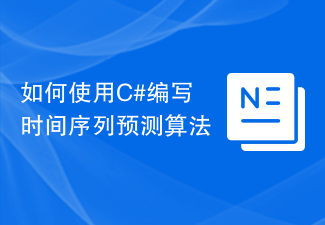 如何使用C#编写时间序列预测算法Sep 19, 2023 pm 02:33 PM
如何使用C#编写时间序列预测算法Sep 19, 2023 pm 02:33 PM如何使用C#编写时间序列预测算法时间序列预测是一种通过分析过去的数据来预测未来数据趋势的方法。它在很多领域,如金融、销售和天气预报中有广泛的应用。在本文中,我们将介绍如何使用C#编写时间序列预测算法,并附上具体的代码示例。数据准备在进行时间序列预测之前,首先需要准备好数据。一般来说,时间序列数据应该具有足够的长度,并且是按照时间顺序排列的。你可以从数据库或者
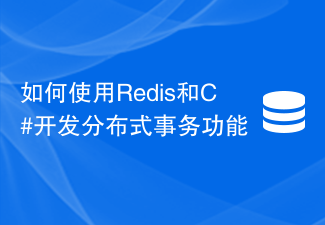 如何使用Redis和C#开发分布式事务功能Sep 21, 2023 pm 02:55 PM
如何使用Redis和C#开发分布式事务功能Sep 21, 2023 pm 02:55 PM如何使用Redis和C#开发分布式事务功能引言分布式系统的开发中,事务处理是一项非常重要的功能。事务处理能够保证在分布式系统中的一系列操作要么全部成功,要么全部回滚。Redis是一种高性能的键值存储数据库,而C#是一种广泛应用于开发分布式系统的编程语言。本文将介绍如何使用Redis和C#来实现分布式事务功能,并提供具体代码示例。I.Redis事务Redis
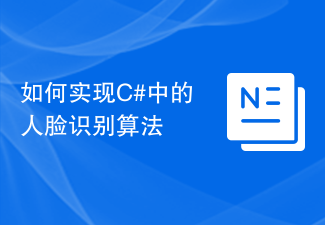 如何实现C#中的人脸识别算法Sep 19, 2023 am 08:57 AM
如何实现C#中的人脸识别算法Sep 19, 2023 am 08:57 AM如何实现C#中的人脸识别算法人脸识别算法是计算机视觉领域中的一个重要研究方向,它可以用于识别和验证人脸,广泛应用于安全监控、人脸支付、人脸解锁等领域。在本文中,我们将介绍如何使用C#来实现人脸识别算法,并提供具体的代码示例。实现人脸识别算法的第一步是获取图像数据。在C#中,我们可以使用EmguCV库(OpenCV的C#封装)来处理图像。首先,我们需要在项目
 如何使用C#编写动态规划算法Sep 20, 2023 pm 04:03 PM
如何使用C#编写动态规划算法Sep 20, 2023 pm 04:03 PM如何使用C#编写动态规划算法摘要:动态规划是求解最优化问题的一种常用算法,适用于多种场景。本文将介绍如何使用C#编写动态规划算法,并提供具体的代码示例。一、什么是动态规划算法动态规划(DynamicProgramming,简称DP)是一种用来求解具有重叠子问题和最优子结构性质的问题的算法思想。动态规划将问题分解成若干个子问题来求解,通过记录每个子问题的解,
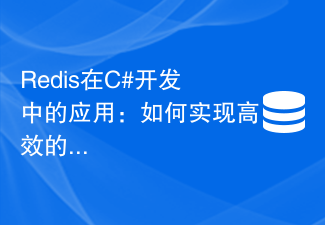 Redis在C#开发中的应用:如何实现高效的缓存更新Jul 30, 2023 am 09:46 AM
Redis在C#开发中的应用:如何实现高效的缓存更新Jul 30, 2023 am 09:46 AMRedis在C#开发中的应用:如何实现高效的缓存更新引言:在Web开发中,缓存是提高系统性能的常用手段之一。而Redis作为一款高性能的Key-Value存储系统,能够提供快速的缓存操作,为我们的应用带来了不少便利。本文将介绍如何在C#开发中使用Redis,实现高效的缓存更新。Redis的安装与配置在开始之前,我们需要先安装Redis并进行相应的配置。你可以
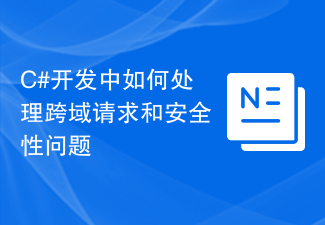 C#开发中如何处理跨域请求和安全性问题Oct 08, 2023 pm 09:21 PM
C#开发中如何处理跨域请求和安全性问题Oct 08, 2023 pm 09:21 PMC#开发中如何处理跨域请求和安全性问题在现代的网络应用开发中,跨域请求和安全性问题是开发人员经常面临的挑战。为了提供更好的用户体验和功能,应用程序经常需要与其他域或服务器进行交互。然而,浏览器的同源策略导致了这些跨域请求被阻止,因此需要采取一些措施来处理跨域请求。同时,为了保证数据的安全性,开发人员还需要考虑一些安全性问题。本文将探讨C#开发中如何处理跨域请
 如何实现C#中的遗传算法Sep 19, 2023 pm 01:07 PM
如何实现C#中的遗传算法Sep 19, 2023 pm 01:07 PM如何在C#中实现遗传算法引言:遗传算法是一种模拟自然选择和基因遗传机制的优化算法,其主要思想是通过模拟生物进化的过程来搜索最优解。在计算机科学领域,遗传算法被广泛应用于优化问题的解决,例如机器学习、参数优化、组合优化等。本文将介绍如何在C#中实现遗传算法,并提供具体的代码示例。一、遗传算法的基本原理遗传算法通过使用编码表示解空间中的候选解,并利用选择、交叉和
 如何实现C#中的图像压缩算法Sep 19, 2023 pm 02:12 PM
如何实现C#中的图像压缩算法Sep 19, 2023 pm 02:12 PM如何实现C#中的图像压缩算法摘要:图像压缩是图像处理领域中的一个重要研究方向,本文将介绍在C#中实现图像压缩的算法,并给出相应的代码示例。引言:随着数字图像的广泛应用,图像压缩成为了图像处理中的重要环节。压缩能够减小存储空间和传输带宽,并能提高图像处理的效率。在C#语言中,我们可以通过使用各种图像压缩算法来实现对图像的压缩。本文将介绍两种常见的图像压缩算法:


Hot AI Tools

Undresser.AI Undress
AI-powered app for creating realistic nude photos

AI Clothes Remover
Online AI tool for removing clothes from photos.

Undress AI Tool
Undress images for free

Clothoff.io
AI clothes remover

AI Hentai Generator
Generate AI Hentai for free.

Hot Article

Hot Tools

mPDF
mPDF is a PHP library that can generate PDF files from UTF-8 encoded HTML. The original author, Ian Back, wrote mPDF to output PDF files "on the fly" from his website and handle different languages. It is slower than original scripts like HTML2FPDF and produces larger files when using Unicode fonts, but supports CSS styles etc. and has a lot of enhancements. Supports almost all languages, including RTL (Arabic and Hebrew) and CJK (Chinese, Japanese and Korean). Supports nested block-level elements (such as P, DIV),

Dreamweaver CS6
Visual web development tools

SublimeText3 Mac version
God-level code editing software (SublimeText3)

SublimeText3 Linux new version
SublimeText3 Linux latest version

SublimeText3 English version
Recommended: Win version, supports code prompts!






